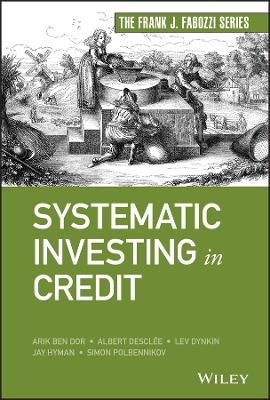
Systematic Investing in Credit
John Wiley & Sons Inc (Verlag)
978-1-119-75128-1 (ISBN)
"Lev and QPS continue to shed light on the most important questions facing credit investors. This book focuses on their latest cutting-edge research into the appropriate role of credit as an asset class, the dynamics of credit benchmarks, and potential ways to benefit from equity information to construct effective credit portfolios. It is must-read material for all serious credit investors."
—Richard Donick, President and Chief Risk Officer, DCI, LLC, USA
"Lev Dynkin and his team continue to spoil us; this book is yet another example of intuitive, insightful, and pertinent research, which builds on the team's previous research. As such, the relationship with this team is one of the best lifetime learning experiences I have had."
—Eduard van Gelderen, Chief Investment Officer, Public Sector Pension Investment Board, Canada
"The rise of a systematic approach in credit is a logical extension of the market's evolution and long overdue. Barclays QPS team does a great job of presenting its latest research in a practical manner."
—David Horowitz, Chief Executive Officer and Chief Investment Officer, Agilon Capital, USA
"Systematization reduces human biases and wasteful reinventing of past solutions. It improves the chances of investing success. This book, by a team of experts, shows you the way. You will gain insights into the advanced methodologies of combining fundamental and market data. I recommend this book for all credit investors."
—Lim Chow Kiat, Chief Executive Officer, GIC Asset Management, Singapore
"For nearly two decades, QPS conducted extensive and sound research to help investors meet industry challenges. The proprietary research in this volume gives a global overview of cutting-edge developments in alpha generation for credit investors, from signal extraction and ESG considerations to portfolio implementation. The book blazes a trail for enhanced risk adjusted returns by exploring the cross-asset relation between stocks and bonds and adding relevant information for credit portfolio construction. Our core belief at Ostrum AM, is that a robust quantamental approach, yields superior investment outcomes. Indeed, this book is a valuable read for the savvy investor."
—Ibrahima Kobar, CFA, Global Chief Investment Officer, Ostrum AM, France
"This book offers a highly engaging account of the current work by the Barclays QPS Group. It is a fascinating mix of original ideas, rigorous analytical techniques, and fundamental insights informed by a long history of frontline work in this area. This is a must-read from the long-time leaders in the field."
—Professor Leonid Kogan, Nippon Telephone and Telegraph Professor of Management and Finance, MIT
"This book provides corporate bond portfolio managers with an abundance of relevant, comprehensive, data-driven research for the implementation of superior investment performance strategies."
—Professor Stanley J. Kon, Editor, Journal of Fixed income
"This book is a treasure trove for both pension investors and trustees seeking to improve performance through credit. It provides a wealth of empirical evidence to guide long-term allocation to credit, optimize portfolio construction and harvest returns from systematic credit factors. By extending their research to ESG ratings, the authors also provide timely insights in the expanding field of sustainable finance."
—Eloy Lindeijer, former Chief of Investment Management, PGGM, Netherlands
"Over more than a decade, Lev Dynkin and his QPS team has provided me and APG with numerous innovative insights in credit markets. Their work gave us valuable quantitative substantiation of some of our investment beliefs. This book covers new and under-researched areas of our markets, like ESG and factor investing, next to the rigorous and practical work akin to the earlier work of the group. I'd say read this book—and learn from one of the best."
—Herman Slooijer, Managing Director, Head of Fixed Income, APG Asset Management, Netherlands
ARIK BEN DOR, PHD, is a Managing Director in Barclays QPS and Head of Quantitative Equity Research. He joined QPS in 2004 at Lehman Brothers. Arik oversees research in equities, rates, credit, and hedge funds. Arik co-authored two books and published over a dozen articles in leading industry journals. He is on the editorial boards of the Journal of Portfolio Management and Journal of Fixed Income. Arik holds a PhD in finance from Kellogg School of Management. ALBERT DESCLÉE is a Managing Director in Barclays QPS based in London and is responsible for its European activities. He advises investors on fixed income and multi-asset portfolio construction. Albert joined Barclays in 2008 from Lehman Brothers. Prior to this, he worked at Salomon Brothers in London. Albert graduated from the Catholic University of Louvain (Belgium) and obtained an MBA from INSEAD. LEV DYNKIN, PHD, is the Founder and Head of Quantitative Portfolio Strategy (QPS) Group at Barclays Research. Lev and QPS joined Barclays in 2008 from Lehman Brothers where they had been a part of Global Research since 1987 and helped launch the Lehman fixed income indices. For over a decade, QPS has been top ranked in its category in the Institutional Investor Research survey. Lev and QPS co-authored three books: A Decade of Duration Times Spread (DTS), Barclays, 2015; Quantitative Credit Portfolio Management, Wiley, 2011; and Quantitative Management of Bond Portfolios, Princeton University Press, 2007. JAY HYMAN, PHD, is a Managing Director in Barclays QPS. He advises clients on portfolio management relative to traditional benchmarks or liabilities, risk budgeting, style analysis, cost of constraints, sufficient diversification, and index replication. Jay has co-authored three books with QPS colleagues. He joined Barclays in 2008 from Lehman Brothers where he worked in quantitative research since 1991. Jay holds a PhD in Electrical Engineering from Columbia University. SIMON POLBENNIKOV, PHD, is a Managing Director in Barclays QPS. He is responsible for empirical research of all quantitative aspects of the investment process including systematic strategies and investment styles in fixed income, benchmark customization, tactical allocation, and hedging. Simon joined Barclays in 2008 from Lehman Brothers. Simon holds a PhD in empirical finance from Tilburg University, Netherlands.
Acknowledgments ix
Foreword xv
Preface xvii
Introduction xix
Part One Investing in Credit vs. Investing in a Combination of Treasuries and Equities
Chapter 1 Can a Combination of Treasuries and Equities Replace Credit in a Portfolio? 3
Part Two Capitalizing on Index Inefficiencies Fallen Angels: Index Liquidation
Chapter 2 Fallen Angels: Characteristics, Performance, and Implications for Investors 81
Chapter 3 Fallen Angels: Capacity, Transaction Costs, and the Bond-CDS Basis 127
Chapter 4 Introducing the Fallen Angel Reversal Scorecard 163
New Issuance: Index Inclusion
Chapter 5 Issuance Dynamics and Performance of Corporate Bonds 191
Chapter 6 The Value of Waiting to Buy: Inclusion-Delay Investment-Grade Corporate Indices 215
Chapter 7 Concessions in Corporate Bond Issuance: Magnitude, Determinants, and Post-Issuance Dynamics 239
Performance Cost of Investment Constraints
Chapter 8 “Try-and-Hold” Credit Investing 265
Chapter 9 Effect of Rating-Based Stop-Loss Rules on Performance 303
Part Three Performance Implications of Portfolio Characteristics
Chapter 10 Coupon Effects in Corporate Bonds: Pricing, Empirical Duration, and Spread Convexity 333
Chapter 11 Maturity Dependence of Corporate Bond Excess Returns 355
Chapter 12 ESG Investing in Credit 369
Part Four Factor Investing in Credit Value Investing
Chapter 13 Relative Value Investing in Credit Using Excess Spread to Peers 413
Chapter 14 Long-Horizon Value Investing in Credit Using Spread per Unit of Debt-to-Earnings Ratio 435
Momentum Investing
Chapter 15 Equity Momentum in Credit 483
Chapter 16 Corporate Sector Timing Using Equity Momentum 515
Size Effect
Chapter 17 Issuer Size Premium in Credit Markets 527
Combining Factor Strategies
Chapter 18 Integrating Systematic Strategies into Credit Portfolio Construction 563
Chapter 19 OneScore: Combining Quantitative and Fundamental Views in Credit 597
Part Five Using Equity-Related Data, Dynamics, and Instruments
Chapter 20 Does the Post-Earnings-Announcement-Drift Extend to Credit Markets? 613
Chapter 21 Equity Short Interest as a Signal for Credit Investing 653
Index 691
| Erscheinungsdatum | 26.01.2021 |
|---|---|
| Reihe/Serie | Frank J. Fabozzi Series |
| Verlagsort | New York |
| Sprache | englisch |
| Maße | 163 x 234 mm |
| Gewicht | 1247 g |
| Themenwelt | Wirtschaft ► Betriebswirtschaft / Management ► Finanzierung |
| ISBN-10 | 1-119-75128-4 / 1119751284 |
| ISBN-13 | 978-1-119-75128-1 / 9781119751281 |
| Zustand | Neuware |
| Haben Sie eine Frage zum Produkt? |
aus dem Bereich


